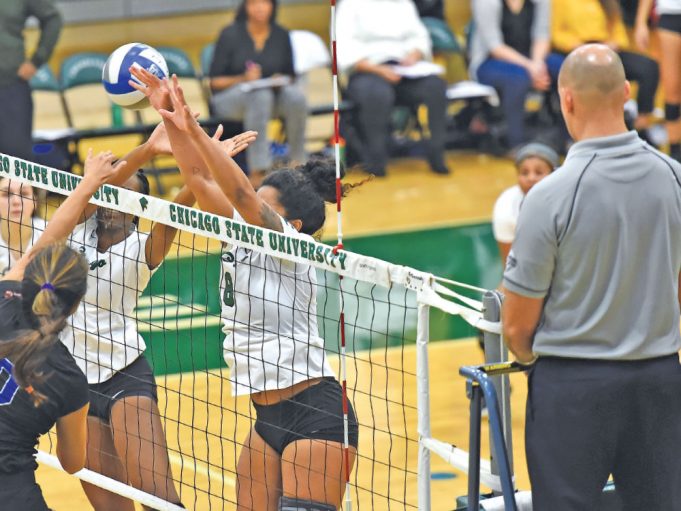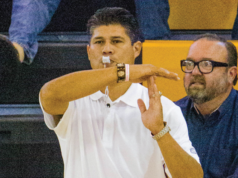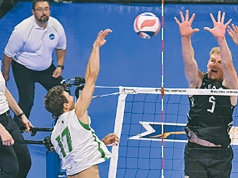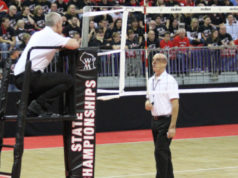During the course of a volleyball match, referees make many decisions. These decisions fall into two categories: 1) violations of a rule, or 2) faults based on judgment. In general, clear violations of the rules and obvious faults that occur during play do not receive much argument. On the other hand, faults that are the result of referee judgment (e.g. ballhandling faults, centerline faults) are often questioned if they do not match up to participants’ expectations or perceptions of what occurred.
What happens when these worlds collide — situations where there might or might not have been a fault, and the referee’s judgment determined the outcome? This is often the case when we have close plays at the net. These plays happen quickly, and often multiple sets of hands are reaching high above the net and near each other, meaning the referee’s position and focus are vital in making the best possible decision. The following is a partial list of potential situations and questions the referee must ask and answer in the second or two of decision-making:
Situation 1: A back-row setter is reaching for a ball that is completely above the top of the net. During that action by the setter, opposing blockers are attempting to block the ball.
Questions/factors — Was the setter’s contact legal (in terms of ballhandling)? Did the setter’s contact send the ball completely across the net or was it directed toward the opponent and legally blocked? Did the blockers reach over the net and contact the ball while it was on the setter’s side, or interfere with the setter’s attempt to play the ball? Did the ball enter the plane and was blocked before the setter played the ball?
Situation 2: A player is reaching for a ball that is completely above the top of the net and may be partially or completely over the opponent’s court.
Questions/factors — Was the ball in the plane of the net? Did the ball completely cross the plane of the net before the player made contact with the ball? Was the player’s contact with the ball legal (in terms of ballhandling)? Was the player who contacted the ball a back-row player? Who (if anyone) contacted the ball next?
Situation 3: Player(s) are above the height of the net and block or attempt to block the ball coming from the attacking team.
Questions/factors — Did the ball enter the plane of the net? Did the blockers actually make contact with the ball or did it rebound from the net tape back to the attacker’s side (possible four hits)? If the blockers reached over the net before the ball entered the plane of the net, was a player on the attacking team close enough to make a play on the ball? If the ball went out of bounds on either side, did the blockers actually make contact with the ball before it went out? Was a back-row player involved in the block? If the ball was still completely on the attacking team’s side and no player on that team was in the area, was the blocking team’s contact with the ball a block or an attack?
How do referees process so many questions within a split second? When you take the time to think about it, it is pretty amazing! This is why we should identify two keys, which could lead to greater success on plays of this nature: 1) knowledge of the rules, and 2) the use of proper techniques.
We have absolute control over one of the keys to success — knowing the rules of the game. Each year we should read and re-familiarize ourselves with the rules. It is important that we identify the sequence of events during a play and then correctly apply the rules.
The second key is all about exposure and experience, and can take many forms. Getting more court time and experience will likely improve your anticipation and judgment of plays close to the net. Watching experienced referees to see what techniques are used and how they handle these situations will also help. Observe both their decision-making and communication with match participants. Finally, consider attending training camps where you can learn the most up-to-date techniques and learn where to focus and why.
When it comes to better decisions on plays close to the net, here are some additional ideas to help you improve: First, you must determine the position of the ball and know who can legally make a play on it.
This means that your body position and focus must be correct to make the best judgment possible. We encourage referees to reduce large, jerky movements and to keep the head still at the moment of decision. The most important thing to remember is to have your eyes stationary when focusing on the position of the ball in relation to the net.
Second, you have to determine if the contact with the ball (whether attacker or blocker) is legal.
This means that your focus must be on the contact of the ball by the player. It is imperative that the referee does not leave the contact early in order to see blockers’ action, as your primary responsibility would include whistling a ballhandling fault.
As you proceed through your volleyball season and work to hone your craft, make it a point to focus where the ball is being contacted to improve your ballhandling judgment and to focus on areas where play will occur to improve your judgment on close plays at the net.
What's Your Call? Leave a Comment:
Note: This article is archival in nature. Rules, interpretations, mechanics, philosophies and other information may or may not be correct for the current year.
This article is the copyright of ©Referee Enterprises, Inc., and may not be republished in whole or in part online, in print or in any capacity without expressed written permission from Referee. The article is made available for educational use by individuals.


















